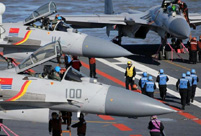

 |
| A CRH train that runs on the Beijing-Shanghai High-Speed Railway leaves Tianjin South Railway Station in North China's Tianjin, June 30, 2012. [Photo/Xinhua] |
China's first high-speed railroad project in Indonesia will arouse more Southeast Asian countries' interest and put their economic growth on a firmer footing through advanced transportation systems and regional connectivity.
China was selected by the Indonesian government to build the nation's first bullet rail link last year. It will start constructing a $5.5 billion high-speed railway line from Jakarta to Bandung on Thursday.
With the operational date scheduled for 2019, the project will be developed by PT Kereta Cepat Indonesia-China, a joint venture formed in October 2015 between a consortium of Indonesian state-owned companies and China Railway International Co Ltd, a subsidiary of China Railway Corp Group.
The project is financed through a Chinese loan provided by China Development Bank which provides around 75 percent of the funding with the rest arranged by the joint venture partners.
Zhou Qinghe, president of CRRC Zhuzhou Electric Locomotive Co, part of the country's largest train manufacturer China Railway Rolling Stock Corp, said China-ASEAN economies will count on enhanced regional cooperation, especially in rail transportation, to stimulate trade and attract investment while improving regional economic integration.
The Chinese train maker has a manufacturing base in Malaysia and is involved in production, assembly, testing, maintenance and refurbishment, with an annual production capacity of 100 electric trains and light railway engines.
"Building the Jakarta-Bandung high-speed railway can help supporting industries such as power generation, logistics, smelting, parts manufacturing, infrastructure, electronics, and even food and beverage service sectors. It will be able to offer a balanced growth in all sectors," said Zhou. Based on distance and technical content, Zhou said the project is expected to generate more than 41,000 jobs a year during construction.
Stations and their surrounding areas will also experience an increase in activity and development, which will result in new opportunities for the real estate sector. Urban and rural areas along the route will also experience balanced development.
Daily passenger flow on the 150-kilometer link is expected to be 44,000 on average and the travel time between the two central hubs will be reduced to less than 40 minutes from the previous three and five hours.
In the ASEAN region, CRRC Zhuzhou's main markets are Malaysia, Indonesia, Singapore and Thailand, with rising demand for both electric locomotives and mass transit trains for city and suburban lines.
"Ongoing plans by Singapore, Indonesia and Malaysia to build a high-speed rail link will further fuel hope that Southeast Asia could one day have a similar European-style railway service system," said Zhang Xiaojing, director of the Institute of Economic Research for China and ASEAN at the Beijing-based University of International Business and Economics.
Zhao said because most Southeast Asian nations have just begun to build new railway lines or bought new trains, they are keen to acquire technological support from China with a relatively low cost to assist in the daily operations, maintenance, staff training and other services.
China Railway Corp, the country's railway operator, said it will accelerate the pace of building both high-speed and regular railways in countries including Indonesia, Malaysia, Russia and the United States, to compete with rivals from Japan, Germany and France.
Sheng Guangzu, general manager of CRC, said the company will deploy more resources and manpower to construct big-ticket international projects such as the China-Thailand railway, the China-Laos railway, the Hungary-Serbia railway and a light rail project in Pakistan this year.
 PLA holds joint air-ground military drill
PLA holds joint air-ground military drill Charming female soldiers on Xisha Islands
Charming female soldiers on Xisha Islands Beautiful skiers wear shorts in snow
Beautiful skiers wear shorts in snow Getting close to the crew on China's aircraft carrier
Getting close to the crew on China's aircraft carrier Chinese stewardess celebrate test flight at Nansha Islands
Chinese stewardess celebrate test flight at Nansha Islands World's first 'underwater skyscraper'
World's first 'underwater skyscraper'  Pentagonal Mart becomes the largest vacant building in Shanghai
Pentagonal Mart becomes the largest vacant building in Shanghai "Rent me as your girlfriend!"
"Rent me as your girlfriend!" A beauty's dancing youth
A beauty's dancing youth Top 20 hottest women in the world in 2014
Top 20 hottest women in the world in 2014 Top 10 hardest languages to learn
Top 10 hardest languages to learn 10 Chinese female stars with most beautiful faces
10 Chinese female stars with most beautiful faces China’s Top 10 Unique Bridges, Highways and Roads
China’s Top 10 Unique Bridges, Highways and Roads Xi arrival shows commitment to Mideast
Xi arrival shows commitment to Mideast Chinese firm aims to build ‘world’s largest cloning factory’
Chinese firm aims to build ‘world’s largest cloning factory’ Qinghai Lake aircraft ban reveals risky trend in wildlife photography
Qinghai Lake aircraft ban reveals risky trend in wildlife photography Foreigners flock to China for cancer, chronic disease treatments
Foreigners flock to China for cancer, chronic disease treatmentsDay|Week